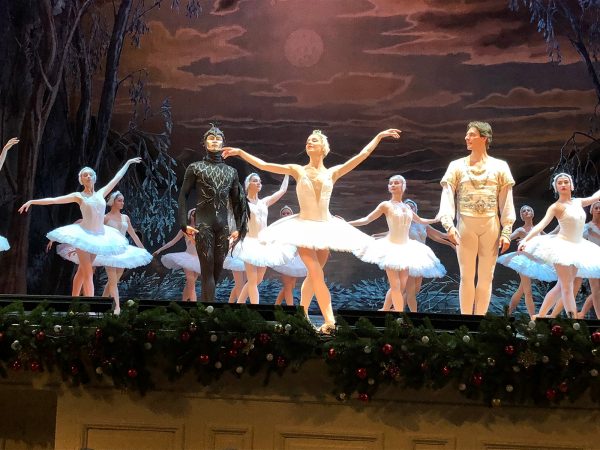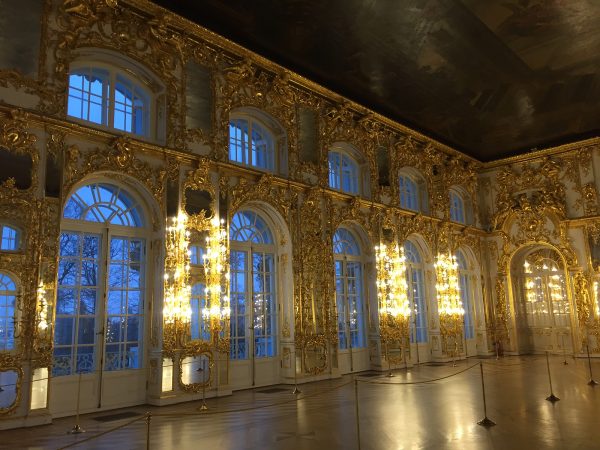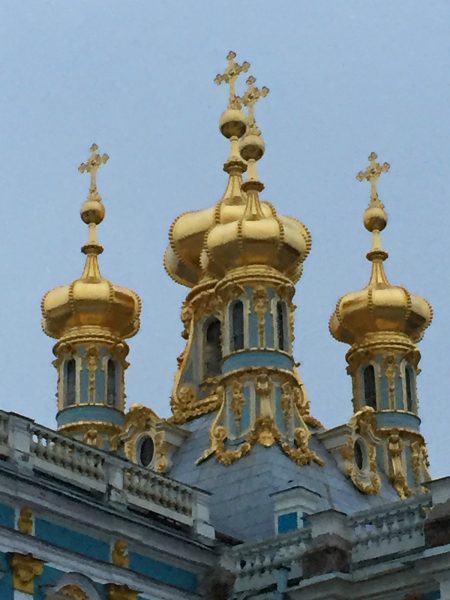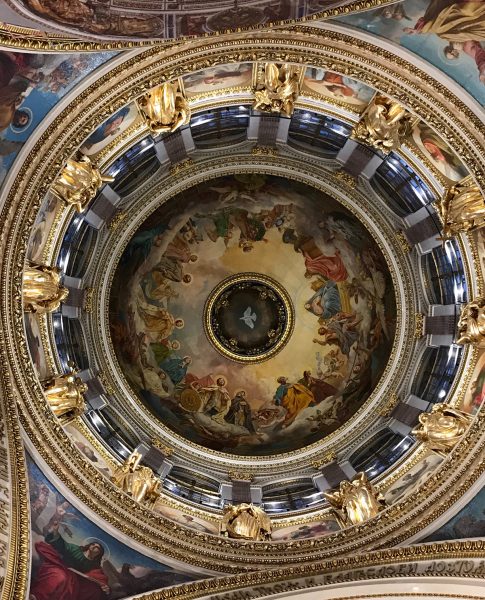The city of St. Petersburg is a relatively new city as it was founded in 1703 by Peter the Great. It’s often referred to as the Venice of the North because of the beautiful palaces situated along the sixty-five islands that make up the city of St. Petersburg. The Courtyard by Marriott Vasilevskly located on the island of the same name is a comfortable and quiet hotel along the Neva River. Because the hotel is located in a residential area, there are few restaurants nearby where you can venture out on your own. This is an excellent hotel however if you are part of a touring group. A metro station to connect you to the entire city is one block away and only a twenty minute walk to the Hermitage. Taxis and Uber are readily available. Our first stop on our four night tour was the Peter and Paul Fortress. Inside St. Peter and St. Paul’s Cathedral we found beautifully painted walls along with marble columns, ornate chandeliers and several tombs of the Romonovs’.
Russian Orthodox churches are very different from other European churches. There are no benches or chairs in the churches as believers stand instead of sitting to show respect to God. Most churches have several holy icons. The central icon of the church is made up of the holy gates in the center, Jesus always situated to the right and Madonna to left. In St. Peter and St. Paul’s Cathedral Jesus is portrayed as a Russian czar to show the czars are close to God.
The Hermitage in St. Petersburg’s is one of the most famous museums in the world, containing over three million artifacts. Founded by Catherine the Great, the museum consists of six buildings of which the most famous is the winter palace. A guide is highly recommended if you have only one day to spend at the museum and be sure to purchase tickets in advance as lines are very long, even in the wintertime. Along with the fabulously decorated palace rooms, we also viewed famous Rembrandt, Da Vinci, and El Greco paintings which are all permanent exhibits. A must see is the elegant gold peacock clock dating back to 1777. Upon the chime, the gold peacock lifts its head, turns it neck and displays its fan of gold feathers. On sight is Catherine the Greats own private theatre where we attended the ballet of Swan Lake.
Two must see churches which are currently museums are St. Isaac’s Cathedral and the Church of the Savior on Spilled Blood. Inside St. Isaac’s Cathedral you can view the ornate brass doors and many religious icons and paintings. Be sure to look at the ceilings in this cathedral. Church of the Savior on Spilled Blood is also known as the Resurrection Church of Our Savor. The church was built on the spot where Alexander II was assassinated and contains many mosaics and Italian marble. The onion domes of the church remind you of a miniature St. Basil’s Church in Moscow.
Located thirty kilometers south of St. Petersburg is the tiny town of Pushkin, the summer palace of Catherine the Great. This fifty-five room palace consists of many state rooms, elaborate staircases, hallways, and the infamous Amber Room. This world famous room is decorated in amber panels backed with gold leaf and mirrors and was shipped to Russia after Peter the Great admired the room in the King of Prussia’s residence. During World War II, the Nazis occupied the residence and in the final months of the war, the Amber Room was dismantled and packed up in crates. To this day, no one knows the location of the original Amber Room panels. The reconstruction of the Amber Room took twenty five years to restore and was completed in the early 2000’s. Upon the Nazis leaving, they set off eleven bombs in the basement of the palace. Ten bombs exploded leaving the palace in utter ruin. The only bomb not to explode was under the church which still stands today. It took decades to restore the summer palace to its former glory and it is well worth the visit.
Back in St. Petersburg we had free time to stroll Nevsky Street with its many restaurants and souvenir shops. If you have a couple of hours free, I would suggest a visit to the privately owned Faberge Museum. Located off the main street of Nevsky, the museum is home to fifteen Easter eggs created by Carl Faberge for the Russian Czars. The eggs were purchased for over one hundred million dollars from Malcom Forbes in 2004. Again purchase tickets in advance and avoid the long line. St Petersburg is a very European type city with its centuries old buildings, exotic churches and many universities. It has the beauty of its location on the Baltic Sea and its wonderful network of canals and rivers throughout the city. While a summertime visit is colorful with gardens in bloom and outdoor cafes in full operation, winter is the time you can experience the spirit of the city with fewer tourists, no cruise ships and a more relaxed atmosphere.





